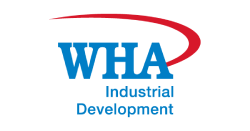ROAD SAFETY
The roads on the premises of industrial estates are used by a variety of stakeholders, which may cause traffic congestion or accidents. As a result, another key safety risk identified during the risk assessment process is road safety. When traveling within the industrial estates, the Group's employees, customers, and commuters may encounter potential road accidents. As a result, the Group implemented the following risk-mitigation measures:
- The installation of speed bumps on its main roads, as well as barrier concrete and a new turnaround lane for incoming vehicles from local roads, in order to alleviate traffic congestion.
- Constant inspection, monitoring, and improvement of road conditions;
- Development of traffic control systems
WHA Group takes road safety very seriously, constantly improving infrastructure and developing technologies to improve road safety to the best of its ability. To address road safety and traffic congestion within the industrial complex, the Group implemented a vehicle management system, which was installed at entrances as stated in the Innovation Management chapter. With this system in place, the WHA Group was able to obtain accurate vehicle counts, license plate numbers, classify car colors, car types, including vehicles that violate traffic rules such as wrong lanes, in order to manage traffic congestion and deal with hit-and-run incidents. At ESIE, approximately 137,754 cars entered the premises per day, for a total of 49,185,040 cars per year in 2021. Furthermore, WHA Group integrated digital transformation to further analyze adaptive traffic control systems that monitor the level of congestion and automatically change traffic lights to allow traffic flow. For instance, WHA ESIE was able to reduce traffic congestion time from 10-15 minutes to 3-5 minutes by using these technologies, and fatalities from traffic accidents were reduced from 2 cases in 2020 to 1 case in 2021, which came from health problems (heart attack) while driving.
Similarly, WHA Group researched the use of drone technology for road and traffic monitoring during peak hours and start using this type of drone in 2021. Drones will aid in the investigation of any road accidents. It can also be used to detect potential risks, which can then be analyzed to identify and implement preventive measures to reduce future accidents. Drones will enable a faster and more effective emergency response in the event of an accident. Reducing the number of accidents will, in turn, reduce traffic on the roads.
In 2021, there were 34 road accidents involving commuters at the Group's industrial estates. The accidents resulted in 22 injured people and 1 fatality, none of whom worked for WHA Group. However, the Group is committed to lowering these figures and will continue to implement road and other safety measures, as well as new innovations, to reduce accident rates.
THE ADAPTIVE TRAFFIC
The Adaptive Traffic project, is implemented in 2021, which is a new technology that will assist in the efficient management of traffic. It is using a real-time traffic light control system that collects data from surveillance cameras and calculates the amount of time required to control the traffic lights. Furthermore, this system helps to reduce traffic congestion, traffic accidents, and saving time, while also lowering the energy consumption and carbon footprint. The process is expected to be completed in the second quarter of 2022.
Furthermore, The Group has assessed the risk points for car accidents that are likely to occur frequently and has made plans to improve them. To reduce the number of car accidents at the Group's operations as much as possible, the WHA Avenue E16 junction was repaired in the Eastern Seaboard Industrial Estate (WHA ESIE) industrial estate in 2021, where three accidents occurred in 2020. Following the revision, the installation of the speed hump and concrete barrier means that no such accidents will occur in 2021.




